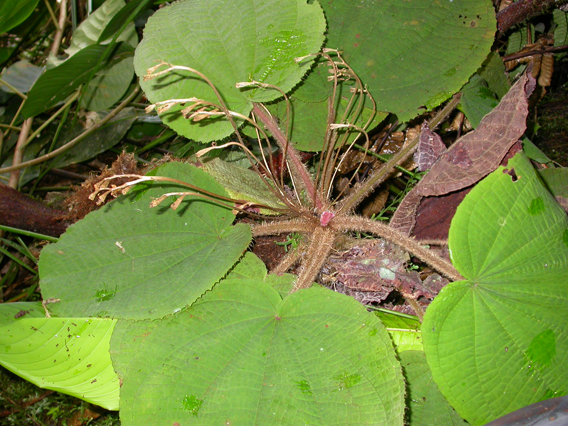Posted:
4/28/2014 |
 Print Friendly Version
Print Friendly Version

Missouri Botanical Garden Herbarium Collection Reaches 6.5 Million Specimens
Garden researcher’s newly described Genus is latest specimen
(ST. LOUIS) The Missouri Botanical Garden’s Herbarium collection reached 6.5 million specimens with the addition of a new genus described by Garden curator Dr. Carmen Ulloa in collaboration with Dr. Fabián Michelangeli and Karla Sosa of The New York Botanical Garden. Their discovery, “Quipuanthus, a New Genus of Melastomataceae from the foothills of the Andes in Ecuador and Peru” was published today in the scientific journal “Systematic Botany.”
In November 2012, Ulloa and her colleagues were examining melastome specimens in the herbarium when they discovered some specimens with peculiar inflorescences from a rosette-like plant that did not match any currently known name species in the plant family. The collections, some gathered more than three decades ago, had been moved from one genus to another without a suitable match. The researchers discovered the flowers had a single series of stamens, a rare characteristic in the melastome family which usually has stamens in double the number of petals. Additional morphological studies, along with anatomical and molecular research, led the authors to describe this new genus with only one known species named Quipuanthus epipetricus Michelangeli & C.Ulloa.
“The Garden’s herbarium is one of the largest and fastest growing in the world and an essential foundation for botanical research,” said Dr. James Solomon, herbarium curator. “The herbarium allows researchers from all over the world to compare dried plant specimens that grow in different regions side by side resulting in exciting discoveries such as this one.”
The authors chose a combination of the Quecha word quipu (meaning record-keeping cords) and the Greek word anthos (flower) to formally name their discovery. Quipu were long knotted strings of fiber used by pre-colonial Andean societies to encode information. The species name epipetricus refers to the fact that all collections of this herb have been found growing on rocks.
“The overall appearance of the flowers and fruits arranged like knots on strings and the unique combination of characters in this genus reminded us of this enigmatic record system used by Andean societies long before the arrival of the Spanish writing system,” said Ulloa.
 Only two populations of the species are known and both are located on the foothills of the Eastern Andes Mountains: one in Ecuador and one in northern Peru. It has been recognized as Endangered according to the conservation status by the International Union for Conservation of Nature. The collection commemorating this herbarium milestone that lead to this discovery was collected in Peru in 1996 during a Missouri Botanical Garden sponsored expedition.
Only two populations of the species are known and both are located on the foothills of the Eastern Andes Mountains: one in Ecuador and one in northern Peru. It has been recognized as Endangered according to the conservation status by the International Union for Conservation of Nature. The collection commemorating this herbarium milestone that lead to this discovery was collected in Peru in 1996 during a Missouri Botanical Garden sponsored expedition.
The Missouri Botanical Garden is one of the three largest plant science programs in the world. The Garden focuses its work on areas that are rich in biodiversity yet threatened by habitat destruction, and operates the world’s most active research and training programs in tropical botany. Garden scientists collaborate with local institutions, schools and indigenous peoples to understand plants, create awareness, offer alternatives and craft conservation strategies. The Missouri Botanical Garden is striving for a world that can sustain us without sacrificing prosperity for future generations, a world where people share a commitment to managing biological diversity for the common benefit. Learn more at www.mobot.org.
# # #
NOTE: Digital images available by request or via Flickr. Download media materials at www.mobot.org/media.
The Missouri Botanical Garden’s mission is “to discover and share knowledge about plants and their environment in order to preserve and enrich life.” Today, 155 years after opening, the Missouri Botanical Garden is a National Historic Landmark and a center for science, conservation, education and horticultural display.
The Missouri Botanical Garden is located at 4344 Shaw Blvd. in St. Louis, just south of I-44 at Vandeventer-Kingshighway (exit #287B). Open 9 a.m. to 5 p.m. daily. Closed Christmas Day. Grounds open at 7 a.m. most Wednesdays and Saturdays (exception: special admission rate events). Admission is $8; free children ages 12 and under and Garden members. St. Louis City and County residents are $4 and free most Wednesdays and Saturdays until noon (exception: special admission rate events – third weekend of May, Memorial Day 2012, Labor Day weekend and first weekend of October). Park for free on site and two blocks west at the Shaw-Vandeventer intersection. The Garden is accessible via public transportation by taking the MetroLink commuter rail line and picking up a Metro bus (www.metrostlouis.org). For general information, log on to www.mobot.org or call the 24-hour recording at (314) 577-5100 or 1-800-642-8842. For membership information, visit www.mobot.org/membership call (314) 577-5118 during weekday business hours. For volunteer opportunities, visit www.mobot.org/volunteer or call (314) 577-5187. The Missouri Botanical Garden is a tobacco-free environment.